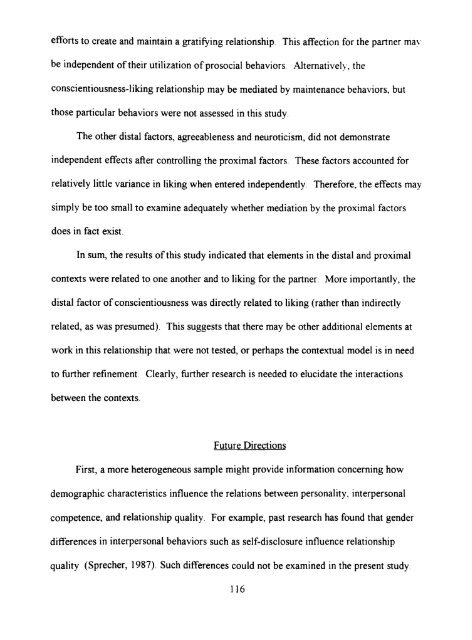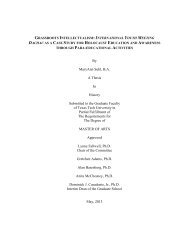THE FIVE FACTORS OF PERSONALITY AND INTERPERSONAL ...
THE FIVE FACTORS OF PERSONALITY AND INTERPERSONAL ...
THE FIVE FACTORS OF PERSONALITY AND INTERPERSONAL ...
Create successful ePaper yourself
Turn your PDF publications into a flip-book with our unique Google optimized e-Paper software.
efforts to create and maintain a gratifying relationship This affection for the partner may<br />
be independent of their utilization of prosocial behaviors Alternatively, the<br />
conscientiousness-liking relationship may be mediated by maintenance behaviors, but<br />
those particular behaviors were not assessed in this study.<br />
The other distal factors, agreeableness and neuroticism, did not demonstrate<br />
independent effects after controlling the proximal factors These factors accounted for<br />
relatively little variance in liking when entered independently Therefore, the effects may<br />
simply be too small to examine adequately whether mediation by the proximal factors<br />
does in fact exist.<br />
In sum, the resuhs of this study indicated that elements in the distal and proximal<br />
contexts were related to one another and to liking for the partner More importantly, the<br />
distal factor of conscientiousness was directly related to liking (rather than indirectly<br />
related, as was presumed). This suggests that there may be other additional elements at<br />
work in this relationship that were not tested, or perhaps the contextual model is in need<br />
to further refinement Clearly, further research is needed to elucidate the interactions<br />
between the contexts.<br />
Future Directions<br />
First, a more heterogeneous sample might provide information concerning how<br />
demographic characteristics influence the relations between personaHty, interpersonal<br />
competence, and relationship quality For example, past research has found that gender<br />
differences in interpersonal behaviors such as self-disclosure influence relationship<br />
quality (Sprecher, 1987). Such differences could not be examined in the present study<br />
116
















